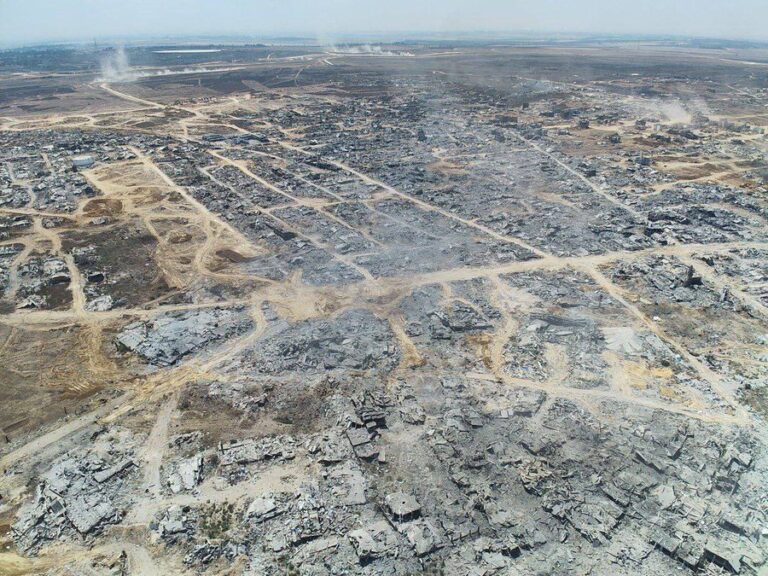Destruction as Policy: Satellite Data Shows 70% of Gaza Obliterated
A Hebrew University study reveals that most of Gaza has been destroyed, far beyond UN estimates. Legal experts warn the campaign may constitute genocide under international law.

New satellite analysis shows nearly 70% of Gaza’s infrastructure destroyed, raising legal concerns over systematic displacement and denial of return. Photo: @Timesofgaza
July 20, 2025 Hour: 1:40 am
Nearly 70% of Gaza’s infrastructure has been destroyed, according to new satellite imagery, revealing what researchers describe as a deliberate campaign to render the territory uninhabitable. The scale of destruction now far exceeds earlier UN estimates.
RELATED:
Critical 1,000 Dead in Syria Sweida Violence Under Ceasefire Amid Israeli Intervention
A detailed satellite analysis by the Geographic Information System (GIS) Centre at the Hebrew University shows that nearly 160,000 buildings in Gaza—close to 70% of all structures—have been destroyed or severely damaged since the start of Israel’s ongoing military offensive.
The findings paint a stark picture of erasure: 89% of buildings in Rafah have been damaged or flattened; in northern Gaza, the figure is 84%, and in Gaza City, 78%.
“The residents of Gaza have nowhere to return to. The world they knew and their daily lives are simply gone,” said Adi Ben-Nun, the lead researcher behind the GIS mapping, which documents widespread destruction not only of homes but also public facilities, health centers, schools, and agricultural land.
While Israel initially relied on airstrikes, the current phase of the campaign has shifted to mechanical demolitions carried out on the ground. These are often executed by private contractors operating under military escort. Israeli media reports suggest these contractors are paid up to 5,000 shekels (roughly \$1,500) per structure and have actively pushed military authorities to expand the demolition zones.
In an interview with Haaretz, Rabbi Avraham Zarbiv—a reservist bulldozer operator involved in the operations—described the process with striking candor: “Rafah is being cleared today; there’s no Rafah. Northern Gaza is almost entirely levelled. Khan Yunis is next – it’ll be wiped out as well.” He added, “God wants our job to be simply clearing the land.”
The devastation has produced an estimated 50 million tonnes of rubble, according to the UN Satellite Centre—an average of 137 kilograms per square metre across the Strip. The UN Environment Programme has warned that this volume of debris is 14 times greater than that created by all global conflicts combined since 2008. Experts estimate that clearing the rubble alone would take over 20 years and cost at least \$1.2 billion.
This level of destruction is not being denied. On the contrary, it is being openly acknowledged and framed as strategic. “We are destroying more and more homes. They have nowhere to return to,” Israeli Prime Minister Benjamin Netanyahu told the Knesset in a recent address. “The only expected outcome will be the desire of Gazans to emigrate out of the Strip.”
Legal experts and human rights monitors say such statements, combined with the visible facts on the ground, raise serious concerns under international law. Article II(c) of the Genocide Convention defines one form of genocide as “deliberately inflicting on the group conditions of life calculated to bring about its physical destruction in whole or in part.”
Observers point to the systematic destruction of shelter, healthcare infrastructure, education systems, and basic services—alongside mass displacement—as clear indicators that the campaign may amount to more than warfare. It may represent, they argue, a coordinated effort to permanently remove Gaza’s population and dismantle the possibility of return.
With nearly three-quarters of Gaza reduced to rubble and top officials framing this destruction as a path to forced emigration, international legal bodies are under increasing pressure to investigate whether Israel’s campaign constitutes a breach of the Genocide Convention. As the evidence mounts, the question confronting the international community is no longer just how Gaza will be rebuilt—but whether its people are being erased by design.
Author: MK
Source: Al Mayadeen





